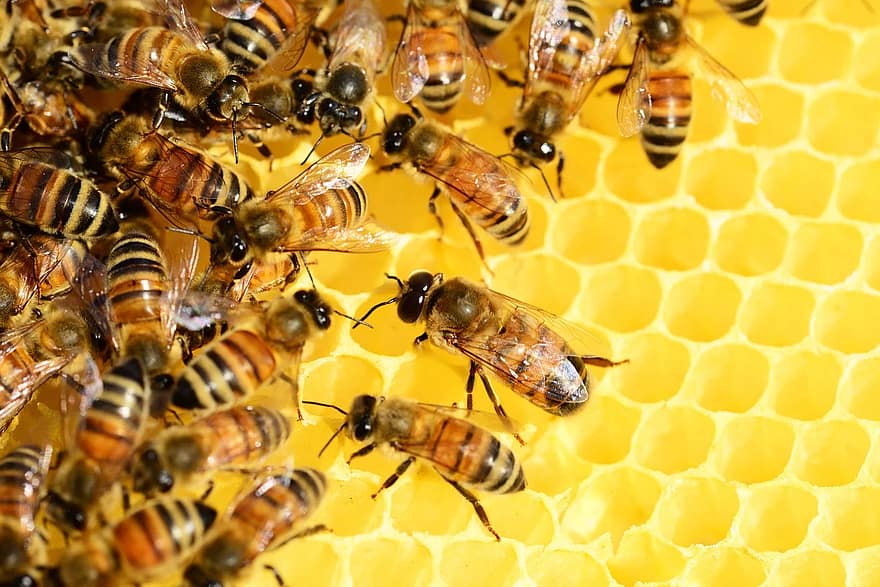

The dance ‘sounds’ are produced by the wings, which act as an asymmetrical dipole emitter. The acoustic near field close to honey bees performing the wagging dance was investigated with pairs of small, matched microphones placed in various positions around the dancing bees (Michelsen et al. 1991 Kirchner 1994), and this is the only natural context, other than its possible use in the control of flight (Heran 1959 in Towne 1994), in which the sensory system is known to be used (Dreller and Kirchner 1993b). This sensory system, which is sensitive to air vibrations up to about 500 Hz, is well suited to detect the 200-300 Hz sounds produced by dancing bees (Kirchner et al. Hunt and Richard (2013)Īir-particle oscillations (sound) cause the long, thin antennal flagellum to vibrate, and the Johnston’s organ registers these movements (Towne 1994). They convert mechanical vibrations into nerve impulses relayed to the brain (McNeil 2015).įigure 1 – The Johnston’s organ (A) and subgenual organ (B) are the primary receptors for vibroacoustic signals (sound). The Johnston organ consists of over 300 nerve cells (scolopidia), arrayed in a bowl shape. The antennal flagella can detect movement to 20 nm and are sensitive to low intensity stimuli of 265-350 Hz. They are found in the second segment (pedicel) of the antennae, and each detects minute motion of the end segment (flagellum). The Johnston’s organs found within the honey bees antennae (Figure 1A) are a collection of sensory cells that are sensitive to vibration. These behavioral experiments revealed that the sounds are picked up by the Johnston’s organ located within the antennae. Bees which had learned to respond to sound were then manipulated by removing one or both antennae, or fixing a certain joint in the antenna or removing sensory hairs on the head (Kirchner 1993). Sensory structures suitable for perceiving near field sound signals are hair sensilla or the antennae. The same training technique was used to find out which sensory structures are used to pick up the sound signals produced by dancing bees (Dreller and Kirchner 1993a). It turned out that bees hear airborne sounds of low frequencies up to 500 Hz with sufficient sensitivity to pick up the sounds of a dancing nestmate (Kirchner 1993). More recently another training paradigm, in which the bees were trained to turn right or left as they entered a feeder, the correct way being toward the sound source, was used to determine the frequency range and amplitude thresholds of hearing in bees (Kirchner et al.

It was thus concluded that they could hear airborne sound. Bees learned to avoid the shock by leaving a feeder when a sound signal was given. Towne and Kirchner (1989) trained bees to associate a sound with a weak electric shock.
#Honey bee wings series
The belief that bees were completely deaf was refuted by a series of experiments following the discovery that sound signals are emitted by dancing bees. So far it has been shown that they can detect sound frequencies up to about 500 Hz (McNeil 2015). Honey bees produce many frequencies of vibration and sound – from less than 10 to more than 1000 Hz. The frequency of sound waves is heard as pitch a higher wave frequency creates a higher pitch. Sound waves are measured by their frequency in Hertz (Hz), or cycles per second. Travelling sound waves have both pressure and particle movement components. Although they use these muscles to move their wings, they can uncouple their wings to produce heat and generate acoustic signals. Tympanal organs are absent in Hymenoptera (bees, wasps and ants).īees generate sound not only through movement of their wings but also with their thoracic muscles. Three major types of chordotonal organs include: the tympanal organ, Johnston’s organ and subgenual organ. Chordotonal organs are a category of mechanoreceptor sensilla that respond to stimuli ranging from gross motor movements to sound and convert these to neural impulses (Field and Matheson 1998). However, it has been shown that honey bees can detect the air-particle movements associated with airborne sounds (Towne and Kirchner 1989), and they do so using Johnston’s organ, a chorodontal organ in the antennal pedicel (Dreller and Kirchner 1993a). For many years it was thought that bees were totally deaf to airborne vibrations (sound) (Goodman 2003). Vibrations and sounds, collectively called vibroacoustics, play significant roles in intracolony communication in honey bees (Hunt and Richard 2013).


 0 kommentar(er)
0 kommentar(er)
